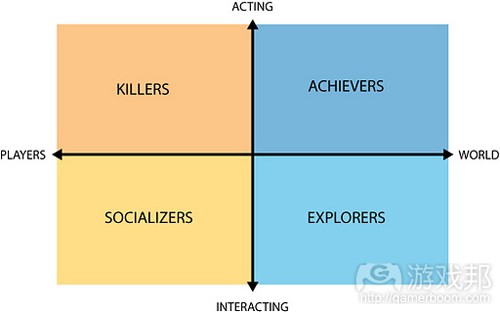未来游戏将更了解各类玩家行为及特点
作者:Graham McAllister
游戏并不会知道我们是什么样的人,但是它们总是尝试去了解我们的内心。当我们打开新游戏时,它往往会让我们从简单、中级和困难3种难度模式中做出选择。但是这种询问有何真正的意义呢?通常来说,难度等级上并没有描述它们之间的区别,就好像让玩家知晓有3个不同的难度等级可供选择而且存在较为困难和简单的模式就足够了。简单和困难只是相对的。
简单模式适用于那些只是想要完成游戏的玩家,他们可以简单地克服游戏中的各种挑战,体验整个故事。困难模式适用于那些想要考验并提升自己技能的玩家,体验高级敌人AI和力量所形成的挑战带来的乐趣。中级模式显得极为神秘,通常还有种表达方式——普通模式。我的猜想时,大多数玩家都会选择该选项。可能部分原因在于,“普通”意味着选择其他选项就等于选择以设计师想法之外的方式来玩游戏。
大体上来说,简单和困难模式各自针对的是“休闲”和“硬核”玩家。游戏行业中往往使用这些术语来描述其目标用户。行业用某些简单的指标将玩家分为休闲或硬核群体,这些指标包括他们每周玩游戏的小时数或之前玩过的游戏数量。但是这些难度并没有完全阐述玩家之所以要选择某个难度模式的原因,以及选择该难度的玩家能够从哪些可玩性元素中获得乐趣。难道就没有根据个人参数来理解玩家的更好方法吗?
Bartle测试
1990年,Richard Bartle询问MUD(游戏邦注:MMOG游戏的原型)玩家,他们希望看到游戏得到怎样的改善。分析评论后发现,玩家大体上分为4个群体:社交者、杀戮者、成就者和探索者。虽然每个玩家表现出来的玩法风格不尽相同,但他们都属于这4种类型。
Bartle总结的分类方法要比将玩家分成休闲和硬核更有意义,因为他的分类方法是以玩家的真实兴趣和玩游戏的动机为基础。但是,即便游戏能够分析我们的行为和识别出我们的玩法类型,它们依然无法分辨我们的情感。
情感优势
尽管在理解玩家的探索中,能够识别玩家的做法算是个良好的开端,但是仅仅识别行为还是不够的。许多游戏的玩法对玩家来说几乎相同,它们的差异在于引起的玩家反应,也就是玩家的情感。在近期的研究中,我们在玩家玩Relentless Software问答游戏《Buzz!》时对他们进行了分析,结果显示Bartle的玩家分类方式也同样适用于社交游戏。其他人发现这种方法也适用于其他类型的游戏。
我们能够识别到4种玩家类型,并非通过他们的行为,而是通过他们对游戏玩法的生理反应。我们在每对玩家身上贴上计量生物感应器,这样就可以精确地了解到他们感到兴奋的时间,随后通过对他们进行采访来了解各种游戏可玩性元素给他们带来的情感。
正如你可以想到的那样,杀戮者的乐趣来源于击败对手,但成就者的乐趣来源于将答案告诉他们的好友,本质上就是炫耀心理。在这种背景下,单纯关注行为的传统指标已经无法识别出各种类型的玩家。但是,通过使用计量生物学,我们可以对玩家进行分类。
总结
有上述想法的不只是我们,索尼刚刚申请了一项计量生物学控制器专利,该控制器包含3个传感器:皮肤电反应、心率和肌肉移动。这项专利甚至陈列出该项技术的某些潜在用途。很显然,索尼似乎已经意识到,下一代视频游戏玩法设计将涵盖我们的心理状态,而不仅仅是通过反馈参数收集到的用户行为习惯。
我们似乎将在很短的时间内,从游戏对我们一无所知的时代进入游戏洞悉我们内心世界的新纪元。(本文为游戏邦/gamerboom.com编译,拒绝任何不保留版权的转载,如需转载请联系:游戏邦)
Opinion: Getting to know you
Graham McAllister
Games have no idea who we are. But they try to ask. Often when we start a new game it will ask us would we like to play at Easy, Medium or Hard difficulty levels. But what is it really asking? Typically, the difficulty levels don’t come with a description to differentiate between them, as if it’s somehow enough for the player to know that there are three levels available and some are harder than others. It’s all relative.
Easy mode is perhaps for those who wish to complete the game, smoothing out any particularly challenging parts so they can experience the full story. Hard mode is for those who wish to hone their dexterity skills, enjoying the challenge of enhanced enemy AI and strength. Medium mode, though, is more intriguing because it’s often known by another name, Normal. I would expect, and you probably will too, that the majority of players choose this option. Partly, perhaps, because ‘Normal’ suggests that selecting another option is choosing to play the game in a way that’s outside what the designer intended.
Broadly, Easy and Hard modes are an attempt to cater for ‘casual’ and ‘core’ players respectively. These terms are often used in the games industry to describe its target audiences. Players are segmented into one of the casual or core groups by primitive measures such as the number of hours they play per week or previous games played. But they completely fail to explain anything about why these gamers play games, or from which gameplay elements they derive their pleasure. Isn’t there a better way to understand players based on their individual characteristics?
Bartle test
In 1990, Richard Bartle asked the players of MUD, the proto MMOG, how they would like to see the game improved. And on analysing their comments found that they broadly fell into four groups: socialisers, killers, achievers and explorers. While each player expressed elements of each playstyle, they would also typically have a dominant style.
The classification Bartle developed is much more meaningful than casual and core, as it is based on players’ actual interests and motivations for playing a game. Incidentally, if you want to know your own style, you can sit an online Bartle test here. However, even if games could analyse our behaviour and identify our playstyle, they have no way of telling our emotions. Or do they?
Emotional advantage
Although identifying what players do is a good starting point in the quest to understanding gamers, behaviour alone is not enough. In many games, the gameplay itself will be exactly the same for all players, but how players react, their emotions, is what differentiates them. In a recent study, we analysed players whilst playing Relentless Software’s Buzz! quiz game, and were able to show that Bartle’s gamer classifications also hold true for this social game. Others have found similar results for different games, too.
We were able to identify the four gamer types not by their behaviour, but by their physiological responses to gameplay. By attaching biometric sensors to each pair of players, we could see precisely at which moments they were getting excited, and by interviewing them afterwards gain insights into which gameplay elements gave them a particular emotion.
There were too many findings to discuss here, but as you would expect, the killers gained enjoyment from beating their opponent, while the achievers experienced enjoyment from telling their friends the answers – in effect showing off. In this context, player identification could not have been achieved with traditional metrics that express pure behaviour – we can certainly create a richer picture of the player by using biometrics.
Inside knowledge
But it’s not just us who think that. Sony recently filed a patent for a biometric controller which contains three sensors: galvanic skin response (arousal), heart rate, and muscle movement. The patent even outlines some potential uses for the tech, and what is clear is that Sony seems to imagine the next wave of video games will have access to our physiological state during gameplay in addition to behaviour collected through metrics.
It seems that in a very short time we may be going from a world in which a game knows nothing about us to one in which it may know a lot. But could it be too much? Will we come to yearn for the halycon days of choosing our difficulty level ourselves instead of our biochemical responses? (Source: Edge)
下一篇:解析游戏设置与引擎代码的分离问题








































 闽公网安备35020302001549号
闽公网安备35020302001549号